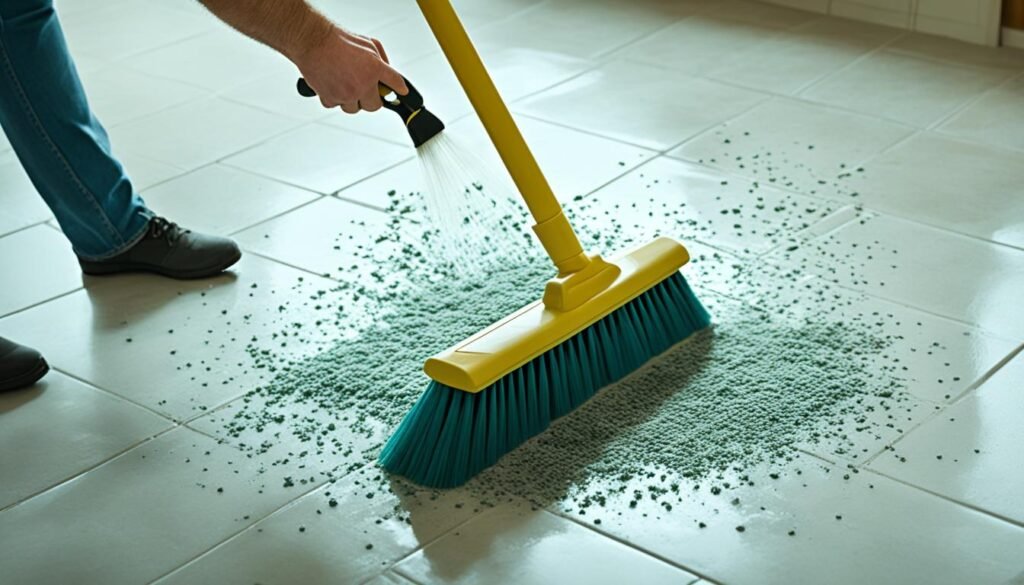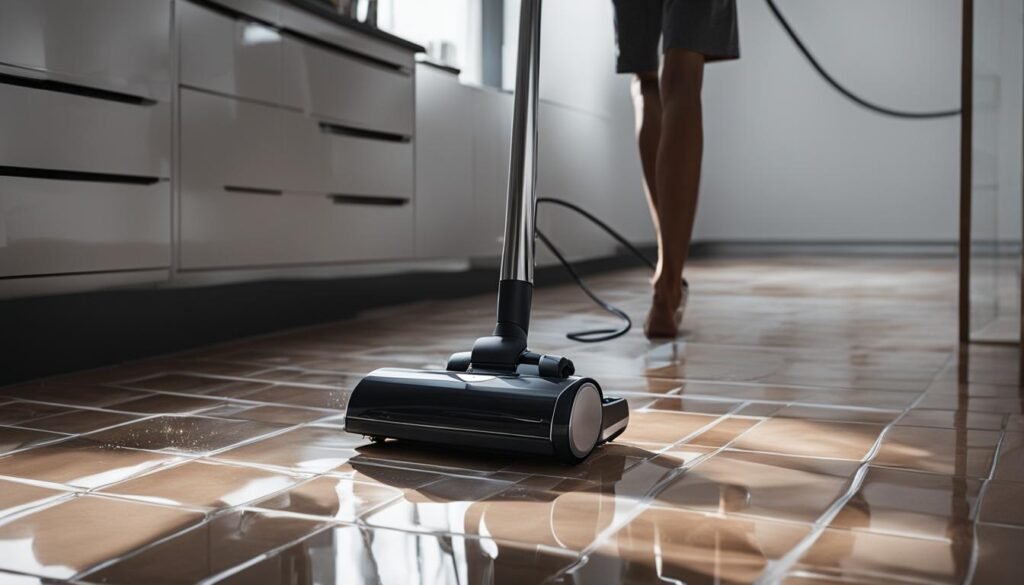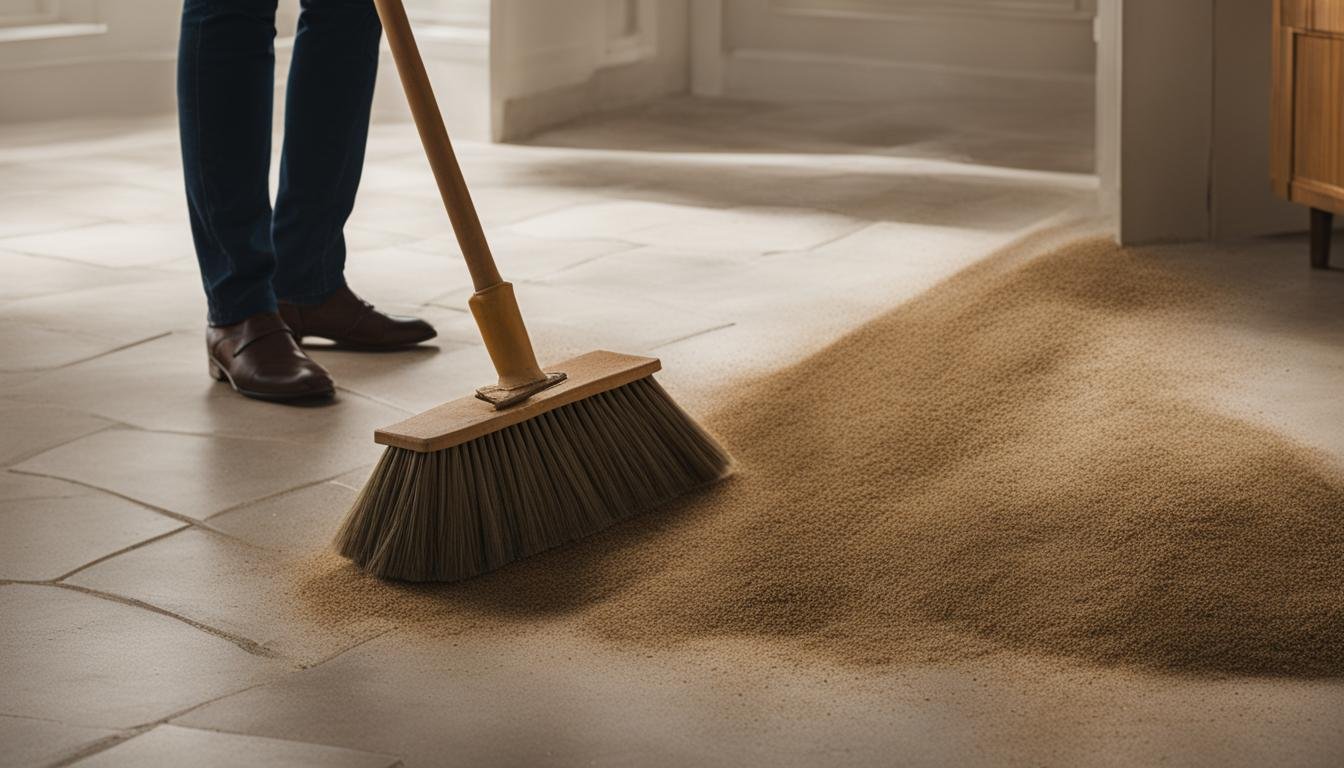When it comes to tile floor cleaning, choosing the right method can make a significant difference in maintaining a sparkling, well-maintained surface. Sweeping and vacuuming are the two main methods for keeping your tile floors clean and free from dust, dirt, and debris. Each method has its own advantages, and understanding them will help you decide on the best approach for your tile floor maintenance.
Key Takeaways:
- Sweeping is a convenient and affordable option for regular maintenance and quick cleanups, but it may not effectively remove fine dust or deeply embedded dirt.
- Vacuuming offers deeper cleaning, better dust and debris removal, and versatility for various surfaces, but it may require more maintenance and caution to avoid scratching sensitive tile floors.
- Consider using a combination of both methods for thorough tile floor cleaning, especially after renovations or for heavily soiled areas.
- Choose the best tools for tile floor cleaning, such as brooms with soft bristles or vacuum cleaners with suitable attachments to protect your floors.
- Regular tile floor care and maintenance will help prolong the life and pristine appearance of your floors.
Pros and Cons of Sweeping
Sweeping is a traditional and widely used method for cleaning tiles. It has several advantages that make it a popular choice for many households.
One of the main advantages of sweeping is its immediate availability. With just a broom in hand, you can clean up dirt and debris without the need to search for attachments or power sources. This convenience makes sweeping a quick and easy way to maintain the cleanliness of your tile floors.
Another advantage of sweeping is that it is a quiet cleaning method. Whether you need to tidy up in the early morning or late at night, you can use a broom without disturbing others. This makes it ideal for households with sleeping babies or noise-sensitive individuals.
Furthermore, brooms are inexpensive and require little upkeep. Unlike vacuum cleaners that may require regular filter changes and maintenance, a broom can be used for a long time without any additional costs. Brooms also take up less storage space compared to bulkier vacuum cleaners, making them an excellent option for those with limited storage areas.
In addition, brooms are versatile and can easily reach hard-to-reach places, such as tight corners and narrow gaps between tiles. They are less likely to leave scratches or scuff marks on tile floors, ensuring the longevity of your flooring. Plus, brooms are lightweight and easy to handle, reducing strain on your arms and back during the cleaning process.
However, it is important to consider the disadvantages of sweeping as well. Sweeping may not be as effective at removing fine dust or deeply embedded dirt, especially in the cracks and corners of tiles. In situations where you need a deep cleaning, such as post-construction or after a major spill, sweeping alone may not be sufficient.

“Sweeping is a quick and easy way to maintain the cleanliness of your tile floors.”
“Brooms are versatile and can easily reach hard-to-reach places, ensuring the longevity of your flooring.”
It is important to weigh the pros and cons of sweeping before deciding on the best cleaning method for your tile floors. While sweeping offers convenience, quiet operation, affordability, and versatility, it may not be as effective for deep cleaning or tackling larger messes. Assess your cleaning needs and consider combining sweeping with other cleaning methods for optimum results.
Pros and Cons of Vacuuming
Vacuuming has become increasingly popular as an effective method for cleaning tile floors. With advancements in technology, many vacuum cleaners now come with attachments specifically designed for hard floors, making it easier than ever to achieve a sparkling clean finish. Let’s explore the advantages and disadvantages of vacuuming tiles, along with some tips for effectively using a vacuum cleaner.
Advantages of Vacuuming
- Efficiency: Vacuuming is generally faster and less labor-intensive compared to sweeping. With modern lightweight models, you can easily maneuver around your tile floors and cover larger areas in less time.
- Effective Dirt and Debris Removal: Vacuum cleaners are equipped with powerful suction that effectively eliminates dirt, debris, and fine dust from the surface of your tiles. This is especially beneficial for those hard-to-reach corners and cracks where dust tends to accumulate.
- HEPA Filtering: Many vacuum cleaners are now equipped with High-Efficiency Particulate Air (HEPA) filters, which capture even the smallest particles, including allergens and pet dander. This is particularly advantageous for those with allergies or respiratory sensitivities.
- Versatility: Vacuum cleaners often come with various attachments and cleaning modes that can be switched for different flooring types and tight spaces. This makes them a versatile cleaning tool that can be used not only on tile floors but also on other surfaces like carpets, drapes, and blinds.
Disadvantages of Vacuuming
- Maintenance: Vacuum cleaners require regular maintenance, such as emptying the dust bin and cleaning the filters. However, this task is relatively simple and can be incorporated into your regular cleaning routine.
- Potential Floor Damage: Certain vacuum heads with sharp or jagged edges can potentially scratch sensitive tile floors. To avoid this, it’s important to choose a vacuum cleaner with a protective brush or suitable attachments that won’t damage your tiles.
Overall, vacuuming offers several advantages for cleaning tiles, including efficiency, effective dirt removal, HEPA filtering, and versatility. However, it’s important to choose a vacuum cleaner that is specifically designed for hard floors and take precautions to prevent any potential damage to your tiles. Now that we’ve explored the pros and cons of vacuuming, let’s move on to the next section to discover some effective techniques for cleaning tiles with a vacuum cleaner.
“Vacuuming is a game-changer when it comes to cleaning tile floors. The powerful suction and diverse attachments make it easier than ever to achieve a spotless finish.” – [Real Name], Cleaning Expert
The table below summarizes the pros and cons of vacuuming tiles:
| Advantages of Vacuuming | Disadvantages of Vacuuming |
|---|---|
| Efficiency | Maintenance |
| Effective Dirt and Debris Removal | Potential Floor Damage |
| HEPA Filtering | |
| Versatility |
Note: Ensure that you choose a vacuum cleaner specifically designed for hard floors and use suitable attachments to avoid any potential damage to your tiles.

Conclusion
In conclusion, the best method for cleaning tile floors ultimately depends on your preferences, cleaning needs, and the condition of your floors. Both sweeping and vacuuming have their advantages and can be used effectively for tile floor maintenance.
Sweeping is a convenient and affordable option that works well for regular maintenance and quick cleanups. It is a quiet method that requires minimal setup and can be easily done with a broom. However, sweeping may not be as effective at removing fine dust or deeply embedded dirt in hard-to-reach places.
On the other hand, vacuuming offers deeper cleaning and better dust and debris removal. Vacuum cleaners come with various attachments that can be used for different flooring types and tight spaces. It is a versatile method that can also be used for cleaning other parts of the home. However, it’s important to choose a vacuum cleaner with suitable attachments or a protective brush to avoid scratching sensitive tile floors.
For thorough tile floor cleaning, a combination of both methods may be necessary, especially after renovations or for heavily soiled areas. By following these cleaning tips and using the best tools for tile floor maintenance, you can keep your floors sparkling clean and in great condition for years to come.
FAQ
What is the best method for cleaning tile floors?
The best method for cleaning tile floors depends on personal preferences and specific cleaning needs. Sweeping and vacuuming are the two main options. Let’s explore the pros and cons of each method to help you choose the best approach for your tile floor maintenance.
What are the advantages of sweeping tiles?
Sweeping is a traditional and widely used method for cleaning tiles. It is immediately available, quiet, inexpensive, and requires little upkeep. Brooms can easily reach hard-to-reach places and are less likely to leave scratches or scuff marks on tile floors.
Are there any disadvantages to sweeping tiles?
Sweeping may not be as effective at removing fine dust or deeply embedded dirt, especially in the cracks and corners of tiles. It can also be less efficient for larger messes or post-construction cleaning.
What are the advantages of vacuuming tiles?
Vacuuming offers several advantages over sweeping. It is generally faster and less labor-intensive, especially with modern lightweight models. Vacuum cleaners come with various attachments for different flooring types and tight spaces, and they are more effective at eliminating dirt, debris, and fine dust.
Are there any disadvantages to vacuuming tiles?
Vacuum cleaners may require more maintenance, such as emptying the dust bin and cleaning filters. Certain vacuum heads with sharp or jagged edges can potentially scratch sensitive tile floors, so it’s important to choose a vacuum with a protective brush or suitable attachments.
Should I choose sweeping or vacuuming to clean my tile floors?
The choice between sweeping and vacuuming depends on your preferences, cleaning needs, and the condition of your floors. Sweeping is convenient, quiet, and affordable, while vacuuming offers deeper cleaning, better dust and debris removal, and versatility for various surfaces. A combination of both methods may be necessary for thorough tile floor cleaning.
How can I effectively clean my tile floors?
To effectively clean your tile floors, consider using a combination of sweeping and vacuuming. Regular maintenance with a broom can help keep your floors clean and free of dirt and debris. For a deeper clean, use a vacuum cleaner with suitable attachments or a protective brush to avoid scratching sensitive tile floors.
What are some tips for tile floor maintenance?
Here are some tile floor maintenance tips: 1) Sweep or vacuum regularly to prevent dirt and debris buildup. 2) Clean up spills and stains promptly to avoid permanent damage. 3) Use a pH-neutral tile cleaner and avoid harsh chemicals that can damage the tiles. 4) Place doormats at entryways to trap dirt and prevent it from being tracked onto the tile floors. 5) Avoid dragging heavy furniture across the tiles to prevent scratches.





Leave a Reply